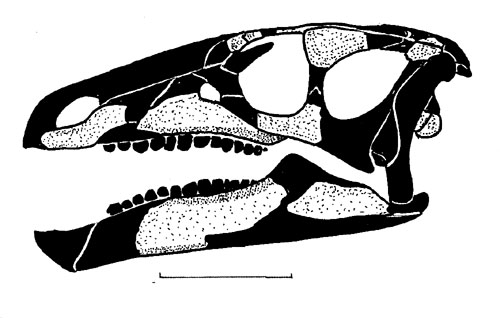
Genus: Cumnoria SEELEY, 1888
Etymology: From Cumnor, Oxfordshire County, England the locality where the specimen was found.
= Cumnovia CARUS, 1888 (sic)
= Cunmoria NOPCSA, 1917 (sic)
Species: prestwichii (HULKE, 1880) GILMORE, 1909
Etymology:
= Iguanodon prestwichii HULKE, 1880
= Camptosaurus prestwichi (HULKE, 1880) Lydekker, 1889 (sic)
= Cumnoria prestwichii (HULKE, 1880) SEELEY, 1888
Holotype: OUM J.3303
Locality: Chawley Brick Pit, Hurst Hill, Cumnor, 2. 5 miles WSW of the centre of Oxfordshire, National Grid reference SP 475 043, Oxfordshire County, England, Southern United Kingdom.
Horizon: Kimmeridge Clay Formation, Ancholme Group.
Biostratigraphy: Eudoxus Zone (originaly Aulacostrephanus pseudomutablilis zone).
Age: LAte Kimmeridgian Stage, Middle Malm Epoch, Late Jurassic.
Material: Fragmentary skull (basiooccipital, basisphenoid, suptraoccipital, exoccipital, parietal, frontals, left postorbital, right and left surangulars, complete and partial right maxillae, left maxilla, maxillary crown tooth, partial right dentary, left dentary, fragment of left squamosal, partial left prefrontal and jugal, right and left premaxillae, fragments) and skeleton (7 cervical vertebrae, 18 dorsal vertebrae, 6 partial chevrons, dorsal neural arch and centrum, 6 sacral centra, 7 sacral ribs, 37 caudal vertebrae, several partial vertebrae, right and left scapulae, right and left coracoids, sternal bones, right and left humeri, proximal and distal right and left ulnae, partial radii, metacarpal, right and left iliua, ischia and pubes, proximal and distal right and left femora, right and left tibiae, fibulae, astragali and calcanea, phalanges and metatarsals.


Pelvis.

Pelvis.

Pes.
Referred material:
LYDEKKER, 1888
BMNH R716-8: Cast of the calcaneum and astragalus of the type.
_____________________________________________________________________________________